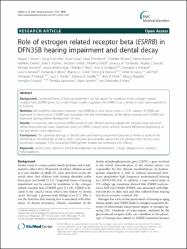Role of estrogen related receptor beta (ESRRB) in DFN35B hearing impairment and dental decay

Göster/
Erişim
info:eu-repo/semantics/openAccessAttribution 4.0 Internationalhttps://creativecommons.org/licenses/by/4.0/Tarih
2014Yazar
Weber, Megan L.Hsin, Hong-Yuan
Kalay, Ersan
Brozkova, Dana Safka
Shimizu, Takehiko
Bayram, Merve
Deeley, Kathleen
Kuchler, Erika Calvano
Forella, Jessalyn
Ruff, Timothy
Trombetta, Vanessa M.
Sencak, Regina C.
Hummel, Michael
Briseno-Ruiz, Jessica
Revu, Shankar
Granjeiro, Jose Mauro
Antunes, Leonardo Dos Santos
Alves Antunes, Livia Azeredo
Abreu, Fernanda
Costa, Marcelo Castro
Tannure, Patricia Nivoloni
Koruyucu, Mine
Patır, Aslı
Poletta, Fernando
Mereb, Juan C.
Castilla, Eduardo Enrique
Orioli, Leda M.
Marazita, Mary L.
Ouyang, Hongjiao
Jayaraman, Thottala
Seymen, Figen
Vieira, Alexandre Rezende
Üst veri
Tüm öğe kaydını gösterKünye
Weber, M. L., Hsin, H.-Y., Kalay, E., Brozkova, D. S., Shimizu, T., Bayram, M. ... Vieira, A. R. (2014). Role of estrogen related receptor beta (ESRRB) in DFN35B hearing impairment and dental decay. BMC Medical Genetics, 15. https://dx.doi.org/10.1186/1471-2350-15-81Özet
Background: Congenital forms of hearing impairment can be caused by mutations in the estrogen related receptor beta (ESRRB) gene. Our initial linkage studies suggested the ESRRB locus is linked to high caries experience in humans. Methods: We tested for association between the ESRRB locus and dental caries in 1,731 subjects, if ESRRB was expressed in whole saliva, if ESRRB was associated with the microhardness of the dental enamel, and if ESRRB was expressed during enamel development of mice. Results: Two families with recessive ESRRB mutations and DFNB35 hearing impairment showed more extensive dental destruction by caries. Expression levels of ESRRB in whole saliva samples showed differences depending on sex and dental caries experience. Conclusions: The common etiology of dental caries and hearing impairment provides a venue to assist in the identification of individuals at risk to either condition and provides options for the development of new caries prevention strategies, if the associated ESRRB genetic variants are correlated with efficacy.
WoS Q Kategorisi
Q4Scopus Q Kategorisi
Q2Kaynak
BMC Medical GeneticsCilt
15Koleksiyonlar
Aşağıdaki lisans dosyası bu öğe ile ilişkilidir:


















